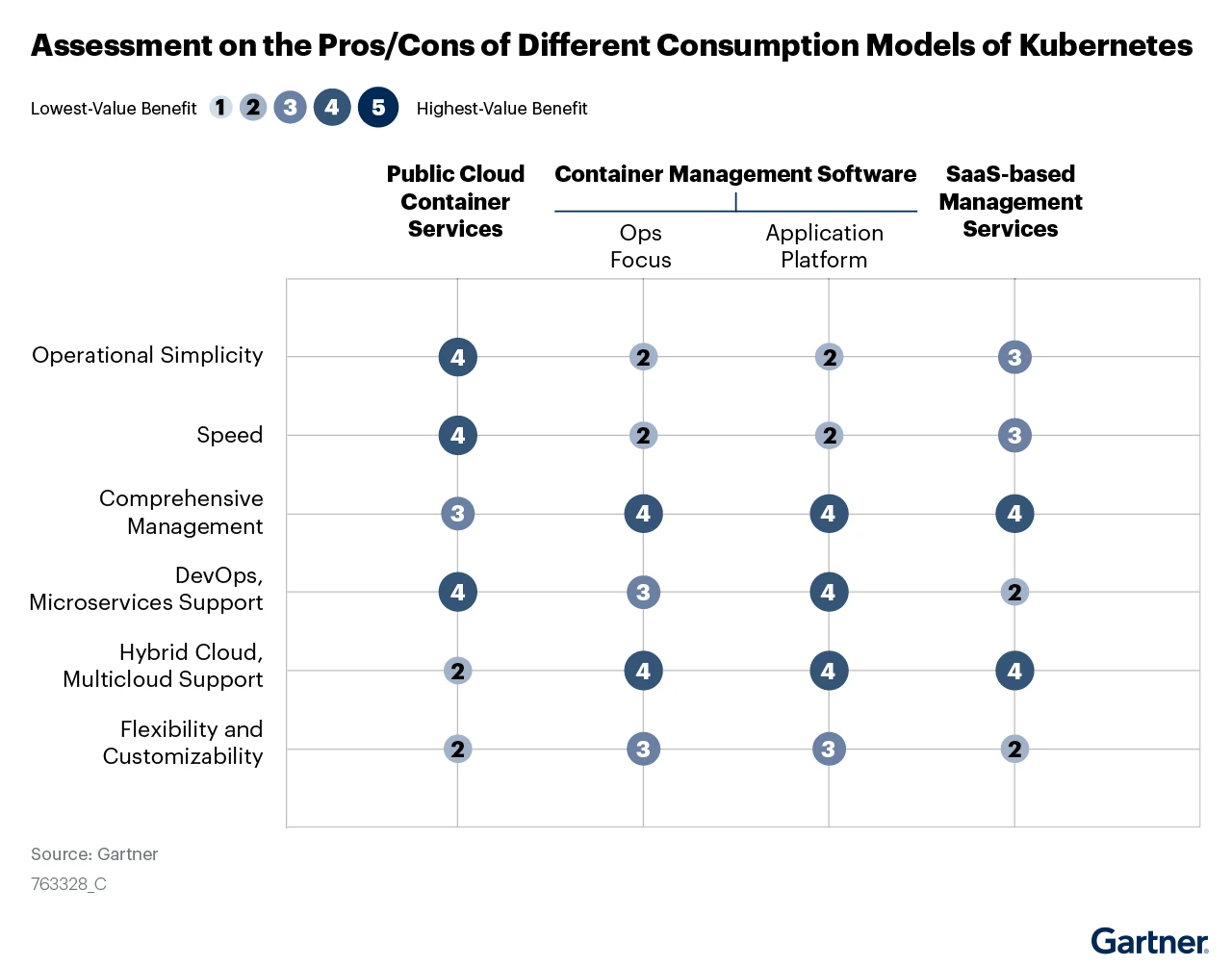As enterprise architecture and technology innovation leaders, it's crucial to understand the
benefits, limitations and best practices associated with building cloud native apps and
modernizing legacy workloads. Gartner recently published a worthwhile read addressing what keeps CTOs up at night while assessing Kubernetes and container adoption.
According to the report, CTOs' Guide to Containers and Kubernetes — Answering the Top 10 FAQs, featuring expert analysis by Arun Chandrasekaran and Wataru Katsurashima, it's no secret that Kubernetes adoption is fast.
"By 2027, more than 90% of global organizations will be running
containerized applications in production, which is a significant increase from fewer than 40% in 2021.", the report reads.
Where should you focus when it comes to optimizing Kubernetes in your organization?
When attending conferences, we often hear about all the success stories, but what about
the real challenges of implementing containers and Kubernetes at scale?
Let's dig into the ten burning questions addressed in the Gartner report — and what we
gleaned from it — to help you decide where to focus your resources, budget and time at
your organization.
Burning Question #1. What are some key benefits of adopting containers and Kubernetes?
By harnessing containers and Kubernetes, organizations can enjoy streamlined development processes and take advantage of the many options available in the modern software landscape. These include agile application development and deployment, environmental consistency, immutability, flexibility, and choice.
Notably, according to Gartner, “containers help simplify application packaging by doing
frequent application builds, quick software releases and granular rollbacks.”
"The ability to develop and deploy software faster can have a significant impact on top-line
growth and customer experience," reads the report. According to Gartner, "this API and cross-platform consistency, open-source innovation and industry support offers a great degree of flexibility for CTOs."
Kubernetes stands out for its is known for its versatility and the extensive
support it receives from a diverse ecosystem of providers.
Burning Question #2. What are the limitations and challenges?
Despite their benefits, containers and Kubernetes also present challenges. These include
platform complexity, security concerns, automation and governance requirements and the
need for a skilled workforce. Being aware of these challenges when considering a large-scale production deployment is crucial.
The report addresses the shortage of skills in the industry and states that "deploying a
common platform like Kubernetes requires clearly defined shared responsibilities across
teams and a growth mindset that can tolerate failures and iterate accordingly."
Indeed, modern enterprise companies will need to establish new collaborative structures to
accelerate product development and delivery.
Burning Question #3. What are some everyday use cases?
Containers and Kubernetes are commonly used in microservices architecture and as DevOps enablers. They provide developers and DevOps teams with more straightforward
modification and updating across the software development life cycle. This, along with
legacy app modernization, serves the goal of further transforming the landscape.
Application portability is another frequently seen use case. According to the Gartner report, "The runtime parity of containers and the ubiquitous availability of Kubernetes enable developers to build apps that can run in a consistent way across hybrid or multi-cloud environments."
Burning Question #4. What about COTS deployment?
We believe container support for commercial off-the-shelf (COTS) applications varies among vendors. And though we see open-source software having more widespread container support, the container support of COTS is, according to Gartner, "steadily increasing."
"Also," Gartner's analysts report, "more ISVs are enabling deeper integrations with
containers/Kubernetes than just providing container images."
Burning Question #5. How do we identify suitable applications?
Determining which applications are suitable for containerization requires reviewing the
container support strategy and roadmaps of strategic COTS ISVs.
Gartner reports that good initial candidates for containerization typically have a low degree
of external application dependencies and a preference for stateless apps.
Other suitable traits addressed in the report are applications with rapid elasticity needs and those requiring frequent code changes.
Burning Question #6. What about measuring ROI?
Like any business endeavor, costs must be considered. While container deployments offer
potential benefits like increased developer productivity, an agile CI/CD environment,
infrastructure efficiency gains and reduced operational overhead, keeping tabs on the
expenses involved is essential.
Chandrasekaran and Katsurashima explain that associated costs may include subscriptions
to CaaS/PaaS, licensing fees, infrastructure acquisition and upgrades and staff acquisition
and training.
Burning Question #7. Which skills and roles will we need?
According to insights from Gartner, the successful adoption of containers and Kubernetes
relies on the correct balance of core and auxiliary roles. These reflect a range of expertise,
from security and platform ops, developer, and platform engineers, build and release
specialists and reliability engineering teams.
Each role has distinct responsibilities within the container and Kubernetes landscape,
collectively handling crucial tasks such as coding, application design, tool selection for the
platform and ensuring the smooth functioning of the continuous integration and deployment (CI/CD) pipeline. The full Gartner report breaks out the skills and requirements for each role and shows how they work together throughout the development and deployment journey.
Burning Question #8. What are the deployment models?
Kubernetes deployment models can be categorized into three patterns: public cloud
container services, container management software for on- and off-premises and SaaS-
based management services.
Here's what the Gartner report says about each:
Public cloud container services: "Users don't have to build or manage Kubernetes
master services, which simplifies operations and improves time to value."Container management software: "Makes it easier to achieve better consistency in
hybrid and multi-cloud environments."SaaS-based management services: "Can enable better operational simplicity and
speed than software."

Burning Question #9. Who are the key Kubernetes platform vendors?
The Kubernetes platform vendor landscape is highly diverse, with a number of key players
and startups. Fortunately, Gartner's report offers a comparative overview of many container management vendors and a comprehensive analysis of their capabilities, strengths and distinguishing features.
Think about your unique requirements and long-term objectives, and then check out the
table in the Gartner report to evaluate the available options and the capabilities the vendors bring to the table.
Burning Question #10. What are the emerging trends?
In their analysis, Gartner dives deep into the latest developments in containers and
Kubernetes, exploring the merging of virtual machines (VMs) with containers, the growing
adoption of stateful applications, the influence of containers in edge computing, the
convergence of serverless computing with containers, and the automation of application
workflows through Kubernetes operators and frameworks such as Kubeflow .
By exploring these emerging trends, enterprise CTOs will gain valuable insights into the
evolving landscape of containers and Kubernetes and the opportunities they present for
businesses and developers alike.
A CTO Game Changer
There's a whole lot to dive into when it comes to these ten burning questions. We're talking
about detailed research outcomes, relevant data points and all levels of technologies in this
fast-paced landscape.
The real game-changers, though, are containers and Kubernetes — today's powerful tools
for modern software development. However, they require careful consideration and planning to maximize their benefits and mitigate their challenges.
---------------------------------------------
Research attributed to Gartner, CTOs' Guide to Containers and Kubernetes — Answering the Top 10 FAQs, 31 May 2022, Arun Chandrasekaran, Wataru Katsurashima
GARTNER is a registered trademark and service mark of Gartner, Inc. and/or its affiliates in
the U.S. and internationally and is used herein with permission. All rights reserved.



